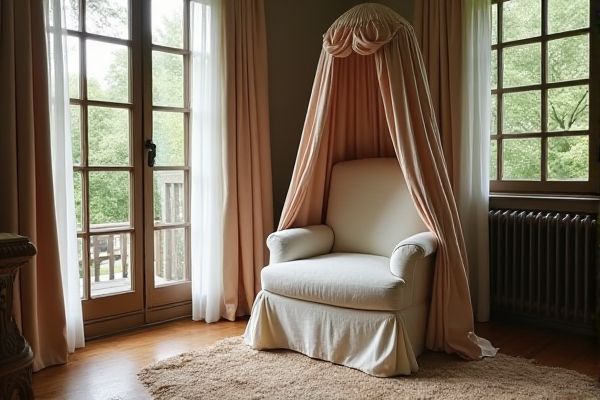
Canopy chairs provide an enclosed, cozy seating experience with their high backs and overhead frame, ideal for creating a private nook, while wingback chairs feature side wings that offer comfort and shield from drafts, making them a classic choice for living rooms. Explore the rest of the article to discover which chair suits your space and style preferences best.
Table of Comparison
| Feature | Canopy Chair | Wingback Chair |
|---|---|---|
| Design | Enclosed seat with a fabric canopy for shade and privacy | High backrest with winged sides extending to the armrests |
| Purpose | Outdoor lounging and sun protection | Indoor seating for comfort and draft protection |
| Materials | Wood or metal frame with fabric canopy | Upholstered wood or metal frame |
| Comfort Features | Spacious seat with shade | Padded back and seat, winged sides for head support |
| Typical Use | Patios, gardens, beaches | Living rooms, libraries, offices |
| Style | Casual, coastal, or rustic | Classic, traditional, or formal |
Overview: Canopy Chair vs Wingback Chair
Canopy chairs feature a tall, enclosed frame with fabric draped over the top, creating a cozy, private seating space ideal for outdoor or drafty indoor areas. Wingback chairs have high backs with distinctive winged sides designed to shield from drafts and provide head support, commonly found in living rooms or studies. Both chair types offer unique comfort and style, with canopy chairs emphasizing enclosure and protection, while wingback chairs focus on ergonomic support and classic elegance.
Historical Origins of Both Chairs
The canopy chair originated in 16th-century Europe as a symbol of status and privacy, featuring a high back with an overhead canopy often used in royal courts. The wingback chair dates back to the late 17th century in England, designed to shield occupants from drafts and retain heat near fireplaces. Your choice between these chairs can reflect a historic style preference rooted in either royal privacy or functional comfort.
Design Features: Canopy Chair Explained
A canopy chair features an overhead frame often draped with fabric, providing a cozy, sheltered seating experience reminiscent of outdoor garden furniture. Unlike wingback chairs, which have high backrests and side wings designed to shield from drafts, canopy chairs emphasize enclosure and privacy through their distinctive canopy structure. Your choice between the two hinges on whether you prefer the protective, enveloping design of a canopy chair or the classic, stately silhouette of a wingback chair.
Design Features: Wingback Chair Explained
The wingback chair features distinctive side panels, or "wings," extending from the backrest to the armrests, originally designed to shield from drafts and trap heat near the sitter. Its high back and deep seat provide exceptional support and comfort, making it a timeless choice for reading or relaxing. Unlike the canopy chair, which includes an overhead cover, the wingback emphasizes enclosed sides for a cozy, protective feel that enhances your personal space.
Comfort and Ergonomics Comparison
Canopy chairs offer a unique ergonomic advantage with their high backrest and enclosed design, providing superior head and neck support as well as a sense of privacy, which enhances overall comfort during prolonged seating. Wingback chairs feature winged sides that provide excellent lateral support and help retain body heat, making them highly comfortable for relaxation and reading sessions. Both chair types cater to different comfort needs, with canopy chairs emphasizing enclosure and upright support, while wingback chairs focus on relaxation and side support.
Material and Construction Differences
Canopy chairs often feature a sturdy wooden frame with a fabric or leather canopy draped over the top, providing a cozy, enclosed seating experience. Wingback chairs are typically constructed with a solid hardwood frame, upholstered with thick padding and fabric or leather, designed for comfort and support with distinctive "wings" extending from the backrest. The canopy chair's emphasis on overhead coverage contrasts with the wingback's focus on side support and insulation from drafts, reflecting their different material and construction purposes.
Suitability for Home Decor Styles
Canopy chairs suit eclectic and bohemian home decor styles by adding a dramatic, cozy focal point with their enclosed design. Wingback chairs complement traditional, classic, and transitional interiors, offering timeless elegance and structured support. Your choice depends on whether you prefer a bold statement piece or a refined, versatile seating option.
Practical Uses and Room Placement
Canopy chairs, with their enclosed design, provide a cozy, private seating option ideal for reading nooks or outdoor patios, serving as a stylish focal point in corners or beneath pergolas. Wingback chairs offer excellent support and comfort, making them suitable for living rooms or bedrooms where relaxation and conversation take place, often positioned near fireplaces or windows. Both chairs enhance room aesthetics but differ in their practical use: canopy chairs shield from elements and create intimate spaces, while wingback chairs emphasize comfort and traditional elegance.
Maintenance and Durability Considerations
Canopy chairs, often crafted from weather-resistant materials like treated wood and outdoor fabrics, require regular cleaning to prevent mold and fading, making them ideal for outdoor spaces with moderate upkeep. Wingback chairs, typically upholstered with delicate fabrics or leather, demand consistent vacuuming and occasional professional cleaning to maintain their durability and appearance indoors. Your choice should align with the environment and your willingness to perform specific maintenance to extend the lifespan of the chair.
Which Chair Is Right for You?
Canopy chairs offer a cozy, enclosed seating experience with their high backs and upholstered sides, making them ideal for creating private nooks or enhancing traditional decor. Wingback chairs provide excellent support and a stylish silhouette, perfect for reading corners or living rooms seeking classic elegance and comfort. Your choice depends on whether you prefer the immersive privacy of a canopy chair or the timeless charm and support of a wingback chair.
 homyna.com
homyna.com